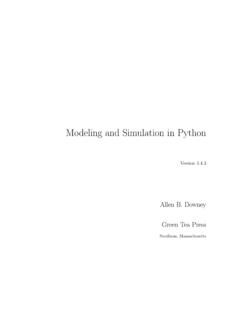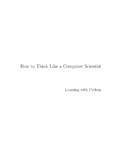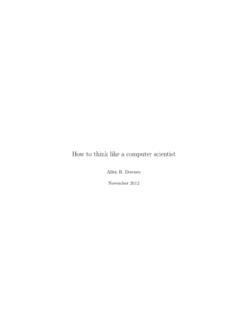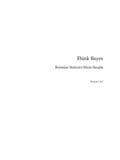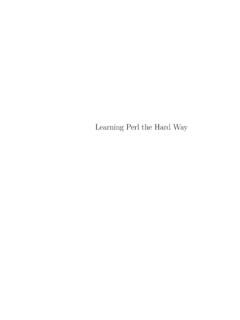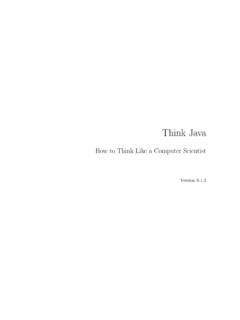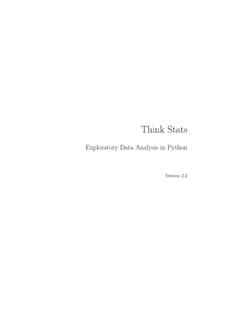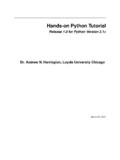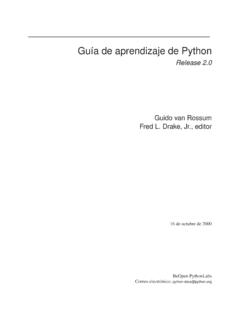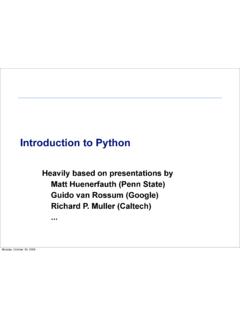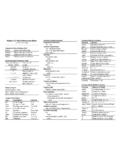Transcription of Think Python - Green Tea Press
1 Think PythonHow to Think Like a Computer ScientistVersion PythonHow to Think Like a Computer ScientistVersion DowneyGreen Tea PressNeedham, MassachusettsCopyright 2012 Allen Tea Press9 Washburn AveNeedham MA 02492 Permission is granted to copy, distribute, and/or modify this document under the terms of theCreative Commons Attribution-NonCommercial Unported License, which is available original form of this book is LATEX source code. Compiling this LATEX source has the effect of gen-erating a device-independent representation of a textbook, which can be converted to other formatsand LATEX source for this book is available strange history of this bookIn January 1999 I was preparing to teach an introductory programming class in Java.
2 I hadtaught it three times and I was getting frustrated. The failure rate in the class was too highand, even for students who succeeded, the overall level of achievement was too of the problems I saw was the books. They were too big, with too much unnecessarydetail about Java, and not enough high-level guidance about how to program. And they allsuffered from the trap door effect: they would start out easy, proceed gradually, and thensomewhere around Chapter 5 the bottom would fall out. The students would get too muchnew material, too fast, and I would spend the rest of the semester picking up the weeks before the first day of classes, I decided to write my own book.
3 My goals were: Keep it short. It is better for students to read 10 pages than not read 50 pages. Be careful with vocabulary. I tried to minimize the jargon and define each term atfirst use. Build gradually. To avoid trap doors, I took the most difficult topics and split theminto a series of small steps. Focus on programming, not the programming language. I included the minimumuseful subset of Java and left out the needed a title, so on a whim I choseHow to Think Like a Computer first version was rough, but it worked. Students did the reading, and they understoodenough that I could spend class time on the hard topics, the interesting topics and (mostimportant) letting the students released the book under the GNU Free Documentation License, which allows users tocopy, modify, and distribute the happened next is the cool part.
4 Jeff Elkner, a high school teacher in Virginia, adoptedmy book and translated it into Python . He sent me a copy of his translation, and I had theunusual experience of learning Python by reading my own book. As Green Tea Press , Ipublished the first Python version in 2003 I started teaching at Olin College and I got to teach Python for the first time. Thecontrast with Java was striking. Students struggled less, learned more, worked on moreinteresting projects, and generally had a lot more 0. PrefaceOver the last nine years I continued to develop the book, correcting errors, improving someof the examples and adding material, especially result is this book, now with the less grandiose titleThink Python .
5 Some of the changesare: I added a section about debugging at the end of each chapter. These sections presentgeneral techniques for finding and avoiding bugs, and warnings about Python pit-falls. I added more exercises, ranging from short tests of understanding to a few substantialprojects. And I wrote solutions for most of them. I added a series of case studies longer examples with exercises, solutions, anddiscussion. Some are based on Swampy, a suite of Python programs I wrote foruse in my classes. Swampy, code examples, and some solutions are available I expanded the discussion of program development plans and basic design patterns.
6 I added appendices about debugging, analysis of algorithms, and UML diagramswith hope you enjoy working with this book, and that it helps you learn to program and Think ,at least a little bit, like a computer B. DowneyNeedham MAAllen Downey is a Professor of Computer Science at the Franklin W. Olin College of thanks to Jeff Elkner, who translated my Java book into Python , which got thisproject started and introduced me to what has turned out to be my favorite also to Chris Meyers, who contributed several sections toHow to Think Like a Com-puter to the Free Software Foundation for developing the GNU Free Documentation Li-cense, which helped make my collaboration with Jeff and Chris possible.
7 And CreativeCommons for the license I am using to the editors at Lulu who worked onHow to Think Like a Computer to all the students who worked with earlier versions of this book and all the con-tributors (listed below) who sent in corrections and ListMore than 100 sharp-eyed and thoughtful readers have sent in suggestions and correctionsover the past few years. Their contributions, and enthusiasm for this project, have been ahuge you have a suggestion or correction, please send email I make a change based on your feedback, I will add you to the contributor list (unlessyou ask to be omitted).
8 If you include at least part of the sentence the error appears in, that makes it easy for me tosearch. Page and section numbers are fine, too, but not quite as easy to work with. Thanks! Lloyd Hugh Allen sent in a correction to Section Yvon Boulianne sent in a correction of a semantic error in Chapter 5. Fred Bremmer submitted a correction in Section Jonah Cohen wrote the Perl scripts to convert the LaTeX source for this book into beautifulHTML. Michael Conlon sent in a grammar correction in Chapter 2 and an improvement in style inChapter 1, and he initiated discussion on the technical aspects of interpreters.
9 Benoit Girard sent in a correction to a humorous mistake in Section Courtney Gleason and Katherine Smith , which was used as a case studyin an earlier version of the book. Their program can now be found on the website. Lee Harr submitted more corrections than we have room to list here, and indeed he should belisted as one of the principal editors of the text. James Kaylin is a student using the text. He has submitted numerous corrections. David Kershaw fixed the brokencatTwicefunction in Section Eddie Lam has sent in numerous corrections to Chapters 1, 2, and 3.
10 He also fixed the Makefileso that it creates an index the first time it is run and helped us set up a versioning scheme. Man-Yong Lee sent in a correction to the example code in Section David Mayo pointed out that the word unconsciously" in Chapter 1 needed to be changed to subconsciously". Chris McAloon sent in several corrections to Sections and Matthew J. Moelter has been a long-time contributor who sent in numerous corrections andsuggestions to the book. Simon Dicon Montford reported a missing function definition and several typos in Chapter also found errors in theincrementfunction in Chapter 13.

